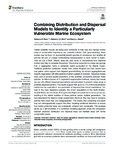Combining Distribution and Dispersal Models to Identify a Particularly Vulnerable Marine Ecosystem
| dc.contributor.author | Ross, Rebecca | |
| dc.contributor.author | Wort, EJG | |
| dc.contributor.author | Howell, Kerry | |
| dc.date.accessioned | 2020-01-15T11:17:34Z | |
| dc.date.available | 2020-01-15T11:17:34Z | |
| dc.date.issued | 2019-09-18 | |
| dc.identifier.issn | 2296-7745 | |
| dc.identifier.issn | 2296-7745 | |
| dc.identifier.other | ARTN 574 | |
| dc.identifier.uri | http://hdl.handle.net/10026.1/15314 | |
| dc.description.abstract |
Habitat suitability models are being used worldwide to help map and manage marine areas of conservation importance and scientific interest. With groundtruthing, these models may be found to successfully predict patches of occurrence, but whether all patches are part of a larger interbreeding metapopulation is much harder to assert. Here we use a North Atlantic deep-sea case study to demonstrate how dispersal models may help to complete the picture. Pheronema carpenteri is a deep-sea sponge that, in aggregation, forms a vulnerable marine ecosystem in the Atlantic Ocean. Published predictive distribution models from United Kingdom and Irish waters have now gained some support from targeted groundtruthing, but known aggregations are distantly fragmented with little predicted habitat available in-between. Dispersal models were used to provide spatial predictions of the potential connectivity between these patches. As little is known of P. carpenteri’s reproductive methods, twenty-four model set-ups with different dispersal assumptions were simulated to present a large range of potential dispersal patterns. The results suggest that up to 53.1% of the total predicted habitat may be reachable in one generation of dispersal from known populations. Yet, even in the most dispersive scenario, the known populations in the North (Hatton-Rockall Basin) and the South (Porcupine Sea Bight) are predicted to be unconnected, resulting in the relative isolation of these patches across multiple generations. This has implications for Ireland’s future conservation efforts as they may have to conserve patches from more than one metapopulation. This means that conserving one patch may not demographically support the other, requiring additional attentions to ensure that marine protected areas are ecologically coherent and sustainable. This example serves as a demonstration of a combined modeling approach where the comparison between predicted distribution and dispersal maps can highlight areas with higher conservation needs. | |
| dc.format.extent | 574- | |
| dc.language.iso | en | |
| dc.publisher | Frontiers Media SA | |
| dc.subject | Pheronema carpenteri | |
| dc.subject | deep sea sponge aggregations | |
| dc.subject | dispersal model | |
| dc.subject | habitat suitability model | |
| dc.subject | vulnerable marine ecosystem | |
| dc.subject | connectivity | |
| dc.subject | metapopulation | |
| dc.title | Combining Distribution and Dispersal Models to Identify a Particularly Vulnerable Marine Ecosystem | |
| dc.type | journal-article | |
| dc.type | Journal Article | |
| plymouth.author-url | https://www.webofscience.com/api/gateway?GWVersion=2&SrcApp=PARTNER_APP&SrcAuth=LinksAMR&KeyUT=WOS:000486545900001&DestLinkType=FullRecord&DestApp=ALL_WOS&UsrCustomerID=11bb513d99f797142bcfeffcc58ea008 | |
| plymouth.volume | 6 | |
| plymouth.publication-status | Published online | |
| plymouth.journal | Frontiers in Marine Science | |
| dc.identifier.doi | 10.3389/fmars.2019.00574 | |
| plymouth.organisational-group | /Plymouth | |
| plymouth.organisational-group | /Plymouth/Faculty of Science and Engineering | |
| plymouth.organisational-group | /Plymouth/Faculty of Science and Engineering/School of Biological and Marine Sciences | |
| plymouth.organisational-group | /Plymouth/REF 2021 Researchers by UoA | |
| plymouth.organisational-group | /Plymouth/REF 2021 Researchers by UoA/UoA07 Earth Systems and Environmental Sciences | |
| plymouth.organisational-group | /Plymouth/Research Groups | |
| plymouth.organisational-group | /Plymouth/Research Groups/Marine Institute | |
| plymouth.organisational-group | /Plymouth/Users by role | |
| plymouth.organisational-group | /Plymouth/Users by role/Academics | |
| plymouth.organisational-group | /Plymouth/Users by role/Researchers in ResearchFish submission | |
| dcterms.dateAccepted | 2019-08-29 | |
| dc.rights.embargodate | 2020-3-7 | |
| dc.identifier.eissn | 2296-7745 | |
| dc.rights.embargoperiod | Not known | |
| rioxxterms.versionofrecord | 10.3389/fmars.2019.00574 | |
| rioxxterms.licenseref.uri | http://www.rioxx.net/licenses/all-rights-reserved | |
| rioxxterms.type | Journal Article/Review | |
| plymouth.funder | Influence of population connectivity on depth-dependent diversity of deep-sea marine benthic biota::NERC |


